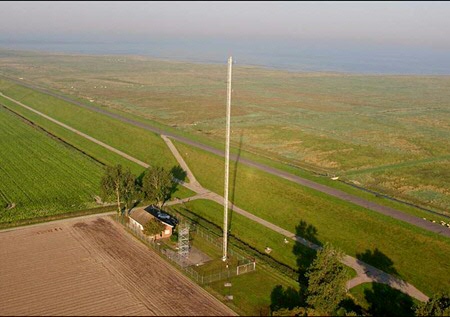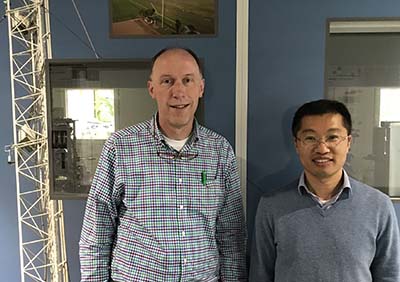University of Groningen greenhouse gas station joins European network
On Thursday 23 May, the atmospheric measurement station Lutjewad from the University of Groningen’s Centre for Isotope Research (CIO) has officially become part of the European Integrated Carbon Observation System (ICOS). The data produced by Lutjewad at the Waddensea will be made publicly available to everyone within 24 hours. In return, University of Groningen scientists can use the data from other stations, all across Europe, for their research.

The ICOS Director General Werner Kutsch officially declared the Lutjewad station part of the ICOS network by signing an official document during the general assembly. Lutjewad is the first of three measurement stations in the Netherlands to officially join ICOS. To get to this point, the scientists from Groningen had to make their station comply to a long series of standards for data acquisition and quality control. ‘This process took about two years’, says Huilin Chen, professor of Atmospheric greenhouse gasses at the Centre for Isotope Research, which is part of the Energy and Sustainability Research Institute Groningen.
The costs of certification were also a problem for the Lutjewad station, which has been in operation since the year 2000. But last year, an NWO grant was awarded through the National Roadmap for Large-Scale Scientific Infrastructure to the Dutch Ruisdael Observatory, a nationwide observatory for measurements of the atmosphere. Lutjewad is part of this observatory and received needed resources to upgrade Lutjewad and cover the costs of ICOS certification.
‘Our main goal is to verify the agreed reduction in carbon dioxide emissions in the Netherlands’, explains Chen. Furthermore, the data can be used to study the sources and sinks for different greenhouse gases. Lutjewad measures all major long-lived greenhouse gases such as carbon dioxide, methane and nitrous oxide, and also aerosols. ‘The wind at our station, which is situated along the Wadden sea, is often south, which means we sample continental air.’ When the wind blows from the North, clean sea air is sampled.
Being part of a European network means Chen and his colleagues will have timely and direct access to high-quality data from all over the continent. ‘This way we don’t have to spend a lot of time asking other scientists for their data, which leaves everyone more time to do actual research.’ The commitment to the network is long time. Chen smiles: ‘Ten years as from last year – which in science means the commitment is more or less permanent.’

Waddensea
The atmospheric monitoring station Lutjewad, in the north of Groningen province at the Waddensea dike in Hornhuizen, was founded by the head of the CIO Prof Harro Meijer. It was officially opened by the commissioner of the queen Hans Alders on September 28, 2000. It consists of a 60 meter tall sampling mast and a laboratory building. Since 2000, measurements of the most important greenhouse gases have been performed continuously. Furthermore, an ever-growing number of additional measurements has been added, which enable scientists to determine the character and origin of greenhouse gas emissions. To support the measurements, meteorological data are collected as well. Most of the instrumentation can be controlled remotely, but the station is visited regularly for maintenance.
More information:
-
Ruisdael Observatory: ruisdael-observatory.nl/
-
ICOS: https://www.icos-ri.eu/icos-national-networks
ICOS, the European Integrated Carbon Observation System is a distributed international research infrastructure dedicated to measure, analyze and understand fluxes of greenhouse gases (GHGs) in the atmosphere, over the ocean and at the ecosystem level. Main overarching questions being tackled are:
-
the understanding of fundamental biogeochemical processes of the carbon cycle;
-
the detection of a potential weakening (or strengthening) of the carbon sink, due to climate change and extreme climate events such as droughts;
-
the monitoring of the long term trends of anthropogenic emissions at scales that are relevant to decision-makers.
Atmospheric measurements of GHG are also used to validate and reduce uncertainties in climate models. They feed inversion or assimilations data fusion systems to produce GHG budget at regional and global levels.
More news
-
15 September 2025
Successful visit to the UG by Rector of Institut Teknologi Bandung
